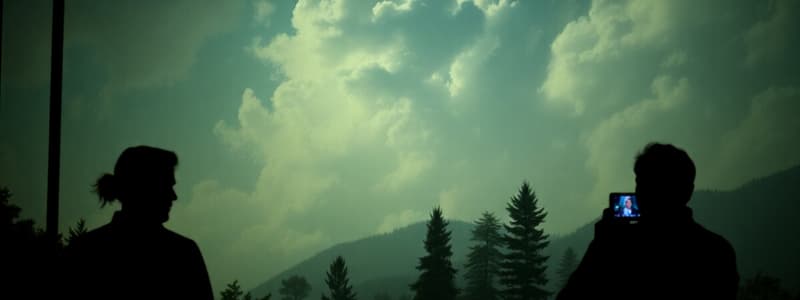Podcast
Questions and Answers
What does the French term 'mise en scène' mean?
What does the French term 'mise en scène' mean?
- Editing process
- Everything within the frame (correct)
- Sound design
- Camera techniques
Which of the following elements is NOT part of 'mise en scène'?
Which of the following elements is NOT part of 'mise en scène'?
- Costume
- Editing (correct)
- Set design
- Props
What are common elements of narratives, such as characters, settings, or themes, referred to as?
What are common elements of narratives, such as characters, settings, or themes, referred to as?
- Media codes
- Audience expectations
- Genre conventions (correct)
- Story structures
Who are the individuals that initiate, plan, and produce media texts?
Who are the individuals that initiate, plan, and produce media texts?
What is the purpose of camerawork in media production?
What is the purpose of camerawork in media production?
Which of the following describes the process of choosing, manipulating, and arranging images and sound?
Which of the following describes the process of choosing, manipulating, and arranging images and sound?
What is the term for people or organizations that share the same interests or intentions?
What is the term for people or organizations that share the same interests or intentions?
What is the role of lighting in media production?
What is the role of lighting in media production?
What element is a significant factor in delivering media texts?
What element is a significant factor in delivering media texts?
What process involves looking into the demographics and psychology of the audience?
What process involves looking into the demographics and psychology of the audience?
What are 'written codes' in media?
What are 'written codes' in media?
What are 'forms conventions' in media?
What are 'forms conventions' in media?
What refers to the reaction of the audience with the media text?
What refers to the reaction of the audience with the media text?
What is the primary purpose of using color in media?
What is the primary purpose of using color in media?
What refers to the anticipation of the audience about the text?
What refers to the anticipation of the audience about the text?
What refers to the strategies utilized by the producers which makes the audience feel that the media text is made specifically for them?
What refers to the strategies utilized by the producers which makes the audience feel that the media text is made specifically for them?
What is the purpose of media language?
What is the purpose of media language?
Which of the following BEST describes media codes?
Which of the following BEST describes media codes?
What are media conventions?
What are media conventions?
Which type of media code relies on interpretation rather than the product itself?
Which type of media code relies on interpretation rather than the product itself?
Which describes written codes in media?
Which describes written codes in media?
What is a wide shot typically used for?
What is a wide shot typically used for?
What does a close-up shot typically show?
What does a close-up shot typically show?
What is the purpose of a cutaway shot?
What is the purpose of a cutaway shot?
Flashcards
Story Conventions
Story Conventions
The basic structures of narratives.
Genre Conventions
Genre Conventions
Commonly used narrative elements (characters, settings, or themes) in a specific type of media.
Media Producers
Media Producers
Individuals who start, plan, and create media texts.
Audience
Audience
Signup and view all the flashcards
Stakeholders
Stakeholders
Signup and view all the flashcards
Audience Analysis
Audience Analysis
Signup and view all the flashcards
Audience Engagement
Audience Engagement
Signup and view all the flashcards
Audience Expectations
Audience Expectations
Signup and view all the flashcards
Wide Shot
Wide Shot
Signup and view all the flashcards
Close Up
Close Up
Signup and view all the flashcards
Cut Away Shot
Cut Away Shot
Signup and view all the flashcards
Medium Shot
Medium Shot
Signup and view all the flashcards
High Angle Shot
High Angle Shot
Signup and view all the flashcards
Low Angle Shot
Low Angle Shot
Signup and view all the flashcards
Media Language
Media Language
Signup and view all the flashcards
Media Codes
Media Codes
Signup and view all the flashcards
Setting (Symbolic Code)
Setting (Symbolic Code)
Signup and view all the flashcards
Acting (Symbolic Code)
Acting (Symbolic Code)
Signup and view all the flashcards
Mise-en-scène
Mise-en-scène
Signup and view all the flashcards
Color (Symbolic Code)
Color (Symbolic Code)
Signup and view all the flashcards
Camerawork (Technical Code)
Camerawork (Technical Code)
Signup and view all the flashcards
Editing (Technical Code)
Editing (Technical Code)
Signup and view all the flashcards
Audio (Technical Code)
Audio (Technical Code)
Signup and view all the flashcards
Forms Conventions
Forms Conventions
Signup and view all the flashcards
Study Notes
- This study guide is for Media and Information Language, focusing on media codes and conventions.
Guess the Shot Activity
- Instructions for "Guess the Shot": Pictures shown need camera shot identified, get 1 point for each correct answer.
- Serve as an initial point for the next activity, with only 15 seconds to answer.
Camera Shots Review
- Wide Shot: Shows the subject and its surroundings to establish context.
- Close Up: Focuses on a subject's face or a specific detail to convey emotion or importance.
- Cut Away Shot: Briefly shifts focus from the main subject to something else, providing additional context.
- Medium Shot: Frames the subject from the waist up, showing both the subject and some of their surroundings.
- High Angle Shot: The camera looks down on the subject, making them seem smaller or vulnerable.
- Low Angle Shot: The camera looks up at the subject, making them appear larger or more powerful.
Processing Questions for the Activity
- The activity involves the use of camera shots and how it is related to the past lesson.
- The activity explores the media language.
Objectives of the Lesson
- Issues are presented to disseminate information using media codes, language, and conventions.
- Evaluate a video clip using codes, conventions, and media language.
- Realize the meaning of a video clip by evaluating it and create a scene using codes, conventions, and language.
Importance of Shot Angles
- Shot angles can significantly affect the film or video
Media Language
- Language, in this context, is described as the medium of communication.
- Media language involves how media producers make meaning about a certain medium and how they transfer that meaning to their target audience
Aspects of Media and Information Language:
- Codes: Commonly have an established meaning like denotation or connotation to the target audience.
- Conventions: The methods in which codes are organized in a product.
Media Codes
Types of Media Codes:
- Symbolic Codes: The meaning is based on the interpretation of the audience and Technical Codes.
- Technical Codes: The knowledge and connotations of camera angles and shots make sense in films and photographs.
- Written Codes: Formal written language used in creating a media product.
Symbolic Codes:
- Settings: The time and place of the narrative or scene.
- Mise en Scene: Everything within the frame, including set design, costume, props, and staging.
- Acting: The portrayal of actors in media production.
- Color: Can be highly connotative and is often associated with cultural aspects.
Color Association
- Red signifies passion, strength, power, and danger.
- Green signifies safety, healing, and money.
- Blue signifies stability, trust, and health.
- Yellow signifies happiness and intellect.
- Orange signifies joy, enthusiasm, and encouragement.
- Brown signifies confidence and casualness.
- Gold signifies wealth, prestige, and wisdom.
- Purple signifies power, luxury, and ambition.
- Pink signifies feminism and romance.
- Black signifies power, elegance, mystery, and death.
- White signifies purity, perfection, and safety.
Technical Codes
- Cameraworks: Involve operating, positioning, and moving the camera for specific effects.
- Editing: The process of choosing, manipulating and arranging images and sounds.
- Audio: Concerns the expressive or naturalistic use of sound.
- Lighting: Manipulation of natural or artificial light to highlight scene elements selectively.
Basic Cameraworks Shots
- Extreme Wide Shot
- Wide Shot
- Medium Shot
- Medium Close Up
- Close Up
- Extreme Close Up
Media Conventions
- Conventions are ways in which types of media codes are arranged
Types of Conventions
- Forms conventions are ways in which media codes are expected to be arranged.
- Story conventions comprise the basic structures of narratives.
- Genre conventions are the common elements in narratives, such as characters, genre settings, or themes.
Other Media Elements
Types of Audience in Media Codes:
- Media Producers: People who initiate, plan, and produce media texts.
- Stakeholders: People or organizations sharing the same interests or intentions.
- Audience: The specific people for whom media and other organizations develop content and shape messages.
Audience Analysis
- Looks into demographics like age, gender, social status, and psychology to determine values, beliefs, and attitudes, also considers the reaction of the audience.
Aspects of Audience Analysis:
- Audience Engagement: Reaction of the audience to the media text.
- Audience Expectations: Anticipation of the audience about the text.
- Audience Foreknowledge: Audience brings the exact information expectations about the media output.
- Audience Identification: Connection built by the media text to the audience.
- Audience Placement: Strategies making the audience feel that produced media texts are specifically for them.
- Audience Research: Monitors the audience before, during, and after media production.
Studying That Suits You
Use AI to generate personalized quizzes and flashcards to suit your learning preferences.




